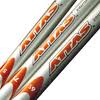 Technology has certainly changed golf equipment in the past decade with the introduction of larger clubheads for drivers and improved golf balls, but there seems little doubt that another big advancement has been the high-tech graphite shafts that are lighter and stronger than the ones previously introduced.
Technology has certainly changed golf equipment in the past decade with the introduction of larger clubheads for drivers and improved golf balls, but there seems little doubt that another big advancement has been the high-tech graphite shafts that are lighter and stronger than the ones previously introduced.
Of course, the price tags are hefty, too, but that has always been the case with graphite when compared to steel.
One of the leaders in this industry is UST Mamiya, which has a sales office located near the DFW International Airport where Robb Schikner, vice president of marketing, noted that more and more of the game’s elite have discovered the advantages of graphite shafts, mainly for drivers, fairway woods and hybrids. As proof, Schikner pointed to 12 wins on the PGA Tour and 25 across the world by players using his company’s graphite shafts.
The latest from UST Mamiya are the ATTAS shafts, distinguished by their tri-color look, notably atomic orange. They cost more, but were immediately adopted by pros around the world. The shaft’s constant taper design reportedly allows more energy to be transferred to the ball for instant feedback with greater distance. The ATTAS T2 features the same great consistency and controllability of the original, but with a tip section specifically engineered to optimize acceleration through impact.
The Proforce shafts, famous for their bright gold color, have been UST Mamiya’s flagship for the last decade and are still preferred by some, but are less expensive options. The V2 incorporates the company’s original “tip technology,” balancing torque, weight, spin and launch angle for extraordinary power off the tee. The latest in the Proforce series, the AXIVCore, features four-axis material promoting stability, control and ease of swing for increased ball speed.
Schikner noted that everyone involved seemed on the same page, agreeing that the shaft was perhaps the most important component of a club. “You can take a great club head from any brand, but if you have the wrong shaft you will not gain the ultimate performance that was originally intended for it,’he said.
That’s why Schikner stressed the importance of going to a club fitter, who can use a launch monitor to find the shaft that will produce the optimum results for a particular golfer.
So that’s what I did, going to Bo Hodnett of Golf Tech in Plano. First, he indicated that buying graphite-shafted clubs off the rack might work for 70 per cent of the golfers, those in the higher handicap category, but that others who shot in the 70s and 80s most likely needed custom fitting to get the best results.
Using the radar-based Velocity monitor, Hodnett can determine a player’s club head speed, spin rate, launch angle, shaft load (tempo of swing) and smash factor (deviation of ball and club head speed outside a normal 1.5 ratio). Then he can put together a profile of the golfer to determine which shaft might work best for him.
My profile showed a club head speed of 83 mph and ball speed of 123 mph, a 15.1 launch angle, a spin rate of 4109 rpm and a medium quick tempo. Hodnett recommended a regular shaft, instead of the stiff I was using, with a tip stiff, instead of mid kick, in 65 grams, giving me a choice of a AXIVCore Tour Red ($150 installed) or an ATTAS 6R ($300 installed) at 45 inches.
“Each company has variations in flex, weight and kick point to allow me to pick a shaft that fits an individual’s profile,” Hodnett said. “For example, with the UST Mamiya AXIVCore, there’s a Tour Black (higher trajectory), a Tour Red (reduces trajectory) and a Tour Green (lower launch and lower spin) in 69, 79 and 89 grams.”
Hodnett indicated he attempted to not be brand conscious when making recommendations, but that many golfers came to the fitting with preconceived notions about a brand preference. “All companies have similar options and I can fit anybody,” he said, pointing out his extensive inventory of graphite shafts that is probably the largest in the DFW Metroplex.
Hodnett agreed with Arnold Palmer’s statement from way back that golfers need to play the most flexible shaft they can control. “That’s sound advice as too many golfers use shafts that tend to be too stiff, losing valuable distance,” he added. That’s exactly what I was doing.
Hodnett and others in the golf industry remind golfers to remember that there may be differences between flex designations (L, A, R, S,X) from one manufacturer to another since there are no real industry standards.
While agreeing that graphite is the best option to gain that extra distance, Hodnett noted that the game’s elite players continued to stay with steel shafts in their “money clubs” where accuracy was more important than distance.
“I do recommend graphite shafts in irons for juniors, ladies and seniors with weak upper body strength or for players who need less vibrations from the shafts for medical reasons,” he added.
